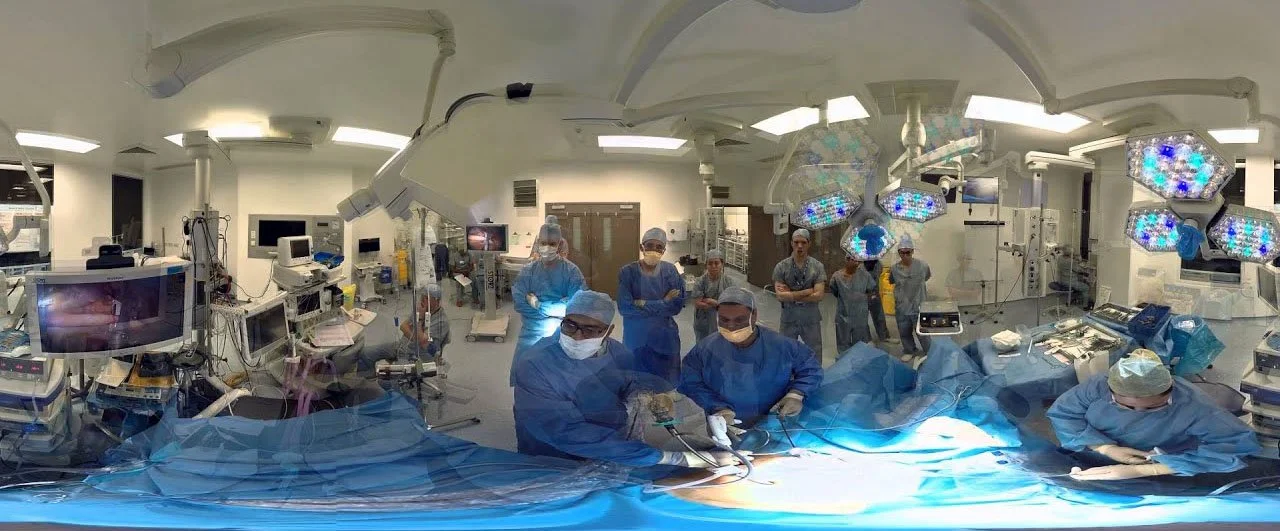The World's First VR Surgery Livestream: A Retrospective
Dr. Shafi Ahmed in the operating theatre wearing a VR headset used to view and navigate the live stream.
I still remember sitting in the studio in April 2016, watching alongside our Chief Technology Officer as it went live. We were just a phone call away in case something failed. Surgeons were prepping their tools. Our team was about to open a free, web-based portal to a live human surgery, broadcast in 360° virtual reality.
Saying that now, in 2025, might sound almost quaint. But at the time, this had never been done. And we’ve come a long way since then.
My role as Creative Lead and visual designer on that pioneering project was clear: optimise the user experience itself. Beyond camera placement and streaming stability, I was responsible for ensuring that tens of thousands of people, many using simple Google Cardboard headsets, would feel, in some sens,e present as Dr. Shafi Ahmed removed cancerous tissue in real time.
Stepping Into Someone Else’s Hands: Designing Presence and Empathy
What struck me most wasn’t just the tech, but its potential for intimacy. Viewers weren’t passive; they could turn their heads, lean in, and grasp the gravity of the moment.
As a designer, my challenge was this: How do you guide the eye without guiding the hand in a 3D space?
We were building something more than a stream. We were choreographing an emotional flow, a balance where education met human reality and distance and closeness collided. This wasn’t just visual design. It was the design of a feeling, a spatial and emotional reality.
As it turns out, this task was impossible, not due to technological or creative constraints, but because of the human nature of the content. A real person on the operating table. Real surgeons working to save a real life. With the bulk of the equipment and the need to stay out of the way, we were incredibly limited in what we could do, and how much real-time change we could implement. For the most part, we had to let the content speak for itself.
The Ripple Effect: From Breakthrough to Blueprint
By today’s standards, it might seem modest. But in 2016, it felt revolutionary. We weren’t just broadcasting surgery. We were broadcasting possibility. Medical students in Lagos, mentors in London, viewers across continents, they all had a seat in the same theatre.
We broke the barrier between doctor and student, between patient and observer. It felt like crossing a threshold. And yet, in hindsight, it was only a small drop into the vast ocean of what was to come.
Fast-Forward to 2025: Immersive Medicine Today
Today, immersive surgery is no longer a novelty. It’s part of a rapidly evolving toolkit.
In operating rooms around the world, surgeons now wear AR overlays that highlight anatomy and guide procedures in real time. Training has moved into fully immersive simulations, rich with haptic feedback and powered by AI, allowing students to practice with near-realistic precision from anywhere in the world.
Specialists collaborate across continents, guiding procedures virtually in shared 3D environments. Patients themselves are no longer passive recipients of information. They can walk through their own anatomy, explore treatment steps virtually, and consent with far greater understanding and confidence.
What once felt like a moonshot is now protocol. In many ways, the ideas we tested experimentally back in 2016 laid the first stones on that path.
A Creative’s Reflection: The Enduring Questions of Spatial Design
That project planted a question that still drives my work: How do I balance presence and empathy in design?
It’s easier to build an environment, whether in 2D, 3D, or through a camera, but it’s far harder to pull a viewer or user into the narrative and truly engage them. We lacked the ability to fully tailor a narrative around a live-action piece in a setting with very real human consequences for mistakes. But I can still see in my mind what could have been, what this experience could have imparted outside of a live stream. That vision helped me in the following years as I developed immersive training systems in healthcare and beyond for brands and companies.
Ultimately, this was part proof of concept, part inspiration, and part novelty. But what it did was open a door, for myself and for the healthcare technology community, to think deeper. Whether I’m building brand-led AR experiences, developing intuitive interfaces for healthcare, or crafting immersive entertainment, this experience stays with me.
To catch attention, you can be bold. But to move people, you have to make them feel seen, understood, and present.
The unedited view from the dual 360° camera rig we positioned to capture the surgical field and team interaction.
Why It Still Matters: A Cultural Shift
Every innovation has roots.
That livestream was more than a technical milestone. It marked a shift in mindset. It quietly proved what was possible. From that point on, immersive medicine had a heartbeat. Human, urgent, and breathtaking.
Being part of that moment wasn’t just thrilling. It was transformational. It changed how I think about space, interaction, and empathy. It reshaped how I approach design. It reminded me of something simple.
The best designs don’t just show us the world. They invite us into it.


